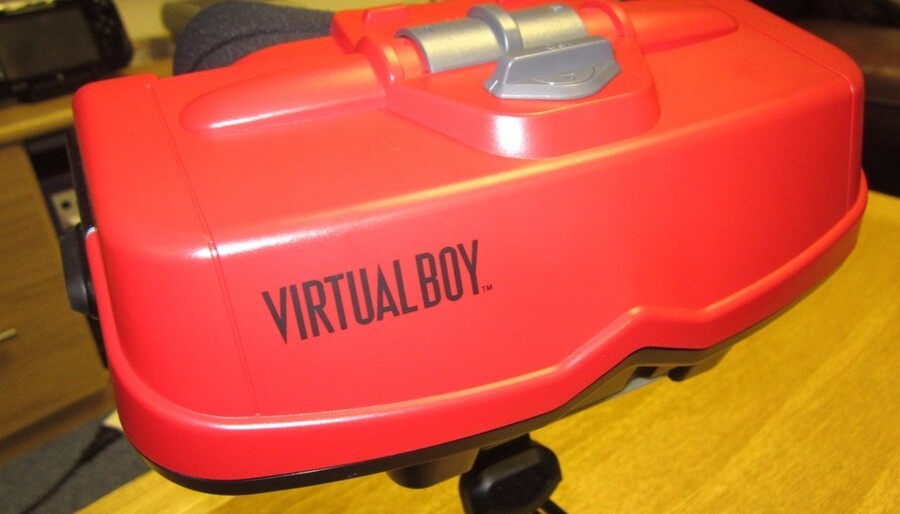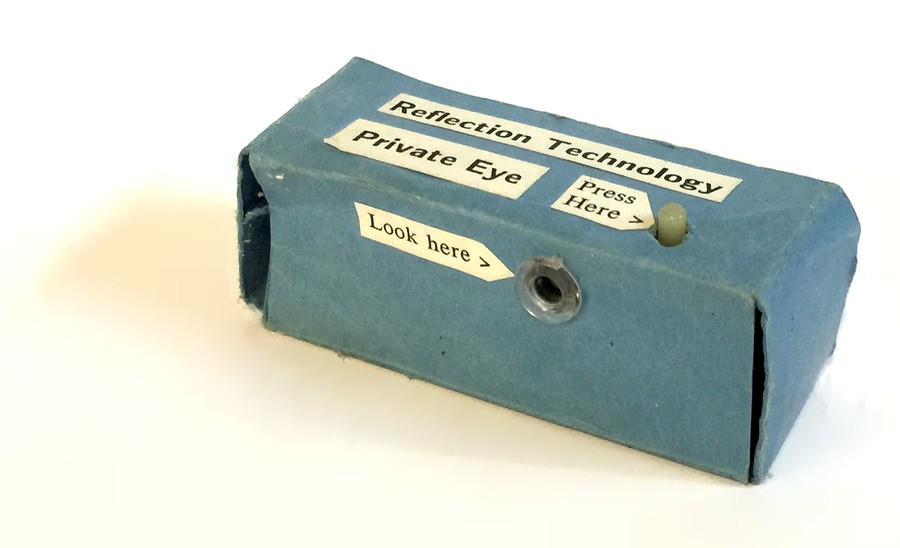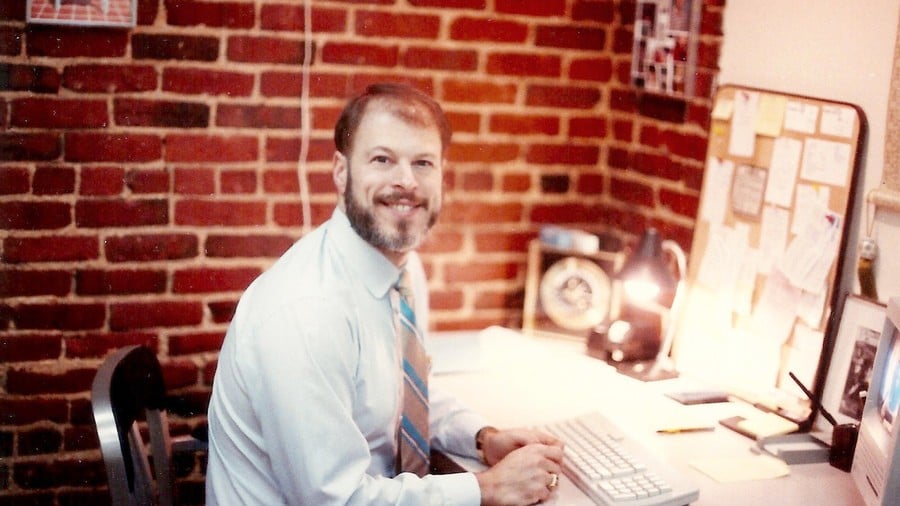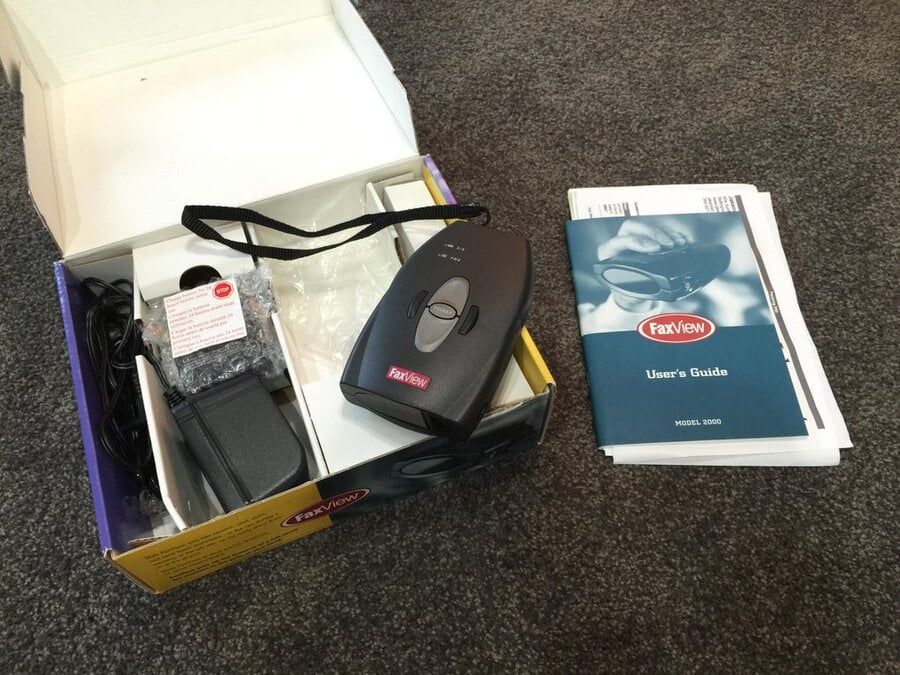
While the dismal commercial performance of the Wii U has made headlines recently, it's a long way from being Nintendo's most famous failure - that unwelcome accolade falls to the Virtual Boy, which sold around 770,000 units globally back in the '90s. The console is blamed not only for ending Gunpei Yokoi's tenure with Nintendo but also for poisoning public opinion on virtual reality. However, a recently-published and in-depth investigative piece by freelance journalist Benji Edwards reveals that many of the assumptions surrounding this flawed platform are false - and that its history is perhaps more interesting that many other consoles.
The story of the Virtual Boy began not in Japan, but in Cambridge, Massachusetts. Around 1985 an engineer named Allen Becker came up with the idea of using LEDs to create a head-mounted personal display. Dubbed a Scanned Linear Array (SLA), the device was cheap, easy to mass-produce and had multiple applications; Becker saw it as a means of viewing information when both hands were needed to do other work. For example, doctors could use it to check vital signs or scans during surgery.
In 1986, Becker formed Reflection Technology, Inc and the device was given a fancy new name: Private Eye. Predating the likes of Google Glass by many years, the technology was shown off at various trade shows but no progress was made on turning it into a viable, selling product - until the virtual reality boom happened.

The public's interest in VR during the early '90s gave Private Eye credibility, but the team was fighting against problems that even modern VR headsets can't solve. A tank demo was created to showcase the gaming potential of the tech, as Benjamin Wells - Reflection's Chief Scientist - recalls:
The whole point of the tank demo was to demonstrate head tracking. As you turned your head to the right, what you saw moved by a corresponding amount. If memory serves me, we were always on the 'too slow' side of the vomit point. I don't recall anybody literally throwing up in the office, but I think we were lucky.
Meetings were held with Mattel, Hasbro and even Sega, but never went to the next stage. Former Sega president Tom Kalinske had more than one problem with the device:
A big issue was kids got sick, threw up, or fell over when using this. We couldn't take that chance.
As I recall, our problem with it was it was just one color. We were already promoting Game Gear in all colors.
Not willing to give up on gaming as a possible application for Private Eye, Reflection's VP of Sales and Marketing Steve Lipsey teamed up with Jack Plimpton to visit Nintendo's Japanese headquarters in 1991. Plimpton had made sure that Gunpei Yokoi was aware of the concept, and thankfully it appealed to Yokoi's desire to use existing, mature and cheap technology in new and interesting ways.
Wells visited Nintendo to give a demonstration of the tank demo, and found the engineer who sat with him to be incredibly enthusiastic. He later discovered that the employee was Yokoi himself:
He fell in love with the technology. He pushed it. He said, 'There's a great product here.'
Yokoi was aware of the limitations of using LEDs, but found the idea of an immersive, darkened environment appealing. He wrote at the time:
The standard way to create 3D images is by using liquid crystals. However, because liquid crystals require backlighting, even in complete darkness, a couple of percentage points of the light seeps out.
The idea was to have it be in total darkness, so you would not feel the frame of the screen.
Yokoi's desire to find a new way to play was also influenced by his growing concern that the gaming industry was becoming too focused on visuals:
I have my doubts as to Nintendo's future if it continues pursuing video games in the same way as before. What should be done to once again engross Famicom and Super Famicom players? If the TV screen medium has reached the limits of its potential, isn't 3D the only option?
Having convinced one of Nintendo's most important staffers, Reflection had to present its product to Nintendo's board of directors - including president Hiroshi Yamauchi. Lipsey travelled to Kyoto to gave his demonstration and Plimpton duly translated. Towards the end of the talk, Lipsey recalls that a dull thud was heard coming from the direction of Yamauchi:
His head fell on his hand, on the table, and he's sound asleep. Everybody else was just sitting there, nobody does anything.
Feeling that the presentation was a waste of time, Lipsey was afterwards reassured by the more savvy Plimpton, who told him:
In Japanese business, that was the senior guy sending the message to his underlings that they could proceed. They didn't need him to be involved anymore—the project is a go!
The green light was given, and Reflection finally had an outlet for its technology. However, almost from the start the project was hit with a series of setbacks. The idea of wearable goggles was dropped early on due to the fact that the 32-bit CPU inside the machine produced high radio emissions near the user's head, and the safety of EMF radiation on the brain was still unknown at the time. A metal plate had to be fitted around the chip, making the unit too heavy to be contained within a pair of goggles. A shoulder-mounted unit was also considered but abandoned due to fears that a child could potentially fall down stairs using the device or have it smashed into their face if involved in a traffic accident. The tabletop form factor we know today was therefore decided upon.

Around this time, even Yokoi himself began to have doubts about the project. Takefumi Makino - who helped Yokoi write his 1997 autobiography Gunpei Yokoi Game Pavilion - recalls:
From what I heard, there were a lot of skeptical opinions raised during the development process. Even Mr. Yokoi admitted that he himself felt uneasy during development. He described it as a kind of 'hiri-hiri' feeling. This is an onomatopoeia that only exists in Japanese, but think about it as the sort of feeling you would get when being cooked slowly over a frying pan.
By this point the system was known as the Virtual Boy, an obvious attempt to cash-in on the success of Yokoi's Game Boy console. Nintendo decided to seek medical advice on whether or not the Virtual Boy's unique display could cause health issues, enlisting Dr. Eli Peli of the Schepens Eye Research Institute in Boston to study the product. It was found that the device was largely harmless, but children whose optic system had not yet fully developed could potentially develop lazy eye if the two displays were misaligned. To counter this, Reflection encased the console in plastic along with a steel frame, removing any chance of the displays being shifted out of alignment.
Yokoi himself was of the opinion that the console was actually beneficial for your eyes:
Far from being bad for your eyes, the Virtual Boy was in fact pretty good for them. But we didn't have time to properly present these findings, and so we gave up trying to include them with the product.
However, thanks to the incredibly strict Japanese Product Liability Act - due to come into effect on July 1st, 1995 - Nintendo was compelled to add health warnings to Virtual Boy packaging listing of the potential risks involved with using the system. While previous gaming consoles had warnings about not playing for too long, this was much more extreme, and most certainly impacted the Virtual Boy's viability in the eyes of concerned parents.
The problems continued to stack up. As Shigeru Miyamoto was busy working on the Nintendo 64, the Virtual Boy failed to benefit from games created with his direct input. In fact, Yokoi wrote at the time that he was told to avoid using Nintendo's biggest IP on his new console:
At first, I had a large list of titles like "Mario Clash," but I was told not to release that kind of stuff. I guess it was an issue of disagreement on how to present the product. For me, it was a perfect game for our target users, but within the company, a lot of people strongly felt that the Virtual Boy would only appeal to a certain crowd of die-hard players.
Upon release, the Virtual Boy flopped badly, only selling 140,000 units in Japan. In North America it fared a little better but was heavily discounted and eventually removed from sale.
Now we come to one of gaming's most infamous footnotes. It is often claimed that the Virtual Boy's demise is what caused Yokoi to leave Nintendo; that he was essentially forced from the company in disgrace. This narrative has been backed up in the past by comments from former Nintendo of America president Howard Lincoln. However, according to Makino, Yokoi had made his mind up about leaving the firm well before the Virtual Boy arrived:
Yokoi's plan was to have the Virtual Boy become a hit, then to help build up Nintendo's main products into three categories: consoles, mobiles, and wearables. Then, he wanted to leave the company.
Yokoi intended to retire from Nintendo at 50 and set up his own company where he would have a greater degree of control over what he worked on. The Virtual Boy threw a spanner in the works as it was such an interesting project that he was willing to delay his retirement in order to work on it. After its failure, he decided to stay on board and create the Game Boy Pocket, a well-recieved hardware refresh of the wildly successful Game Boy. With that done, he handed in his resignation on August 16th, 1996 - 31 years after he joined the firm. Assumptions were made that he left because of the Virtual Boy, and Makino states that such claims "troubled" Yokoi, as they were based on "misunderstandings".

Yokoi would establish Koto Laboratory after leaving Nintendo and work with Bandai on the WonderSwan console. In 1997 he was tragically killed in a traffic accident, aged 56.
As for Reflection Technology - the company which started it all - the story didn't end well. The failure of the Virtual Boy hit the company hard, and its other product - the FaxView - also flopped at retail. The firm was apparently working on a full-colour version of its technology around 1997, but ran out of cash before it could bring the device to market. Al Becker moved onto other ventures, but sadly passed away on October 14th, 2001, aged 53.
It adds another level of tragedy to the already grim Virtual Boy story to know that the two leading figures involved in its inception are now dead. It's a massively misunderstood console that shows just how willing Nintendo is to take risks when so many of its rivals are content to simply recycle existing ideas.
The full feature over at Fast Company is well worth a read, even if the site does run annoying auto-playing videos.
[source fastcompany.com]





Comments 27
Very interesting!
I'll read this in a while.
Makes me wanna get a VB. Any chance of a re-release given how this is 'the year of VR' supposedly - would be fun at the right price.
I enjoyed playing my Virtual Boy for a while, but the weight of the thing and the wonky stand were too much of an issue for me in the end. The controller was not too bad though. Cool article.
@gcunit Your avatar. It's amazing.
@Damo How kind of you - I've been sporting it since the morning Alex's shorts video went live, and despite pimping it in the avatar thread I've only had one other comment I think, so your words are most welcome
I played Virtual Boy at a gaming show only 8 days ago.
They had many of games for it there.
What a great, sad and interesting article. Two inventors that should have lived longer......
So everyone involved is dying in their 50's. Where does that leave the 700k plus people that bought the system........please tell me someone over the age of 60 is still alive that purchased the system......? 😉
THANK YOU for clearing this up! The claim that Yokoi was vengeful of Nintendo for the Virtual Boy (or for anything) always seemed very doubtful, especially when that spurious claim began to be made when Nintendo was beginning to go out-of-style with all the "hardcore" kids and journalists. The Virtual Boy has always been a fine piece of technology and entertainment, but it also has always been mostly misunderstood. Yokoi's concepts for the VB (such as visuals consisting of one-color surrounded by complete darkness) were indeed soundly implemented into the product that Nintendo eventually produced. It was just a bad environment for the system to be released, what with all the rampant paranoia and misinformation spread about it (not to mention the market saturation that the highly-anticipated N64's imminent release helped to worsen, obviously). Of course, Nintendo themselves should have done a better job of marketing and educating about the system (maybe even waiting until after the launch of the N64 to promote and release it?).
But those who steadfastly declare that this is a bad product most always support their assessments by their own improper usage of the system when (and if) they played it, or worse, by "history" and by satirical statements that make them feel accepted by "true" gamers.
I'm interested in Virtual Reality, but Playstation VR and Oculus Rift aren't what I'm excited for.
What I think could be a breakthrough for VR is portability. If there was a dedicated (portable) system for Virtual Reality that had everything (screens, battery and "console"-part) inside it, I would like it.
Currently every VR-set (not including those that use smartphones as screens) need a computer or console to work. There is not a single system that was actually portable. I think that is a big problem for the whole concept of VR.
@gcunit It is indeed amazing.
And regarding Virtual Boy, it's an underrated console and my go-to console for Tetris.
It's often critiziced for giving headaches or making you feel sick, but I'm almost sure it doesn't to anyone if used correctly. It's well known that people who need glasses but don't use them strain their eyes a lot, usually unconsiously and that leads to headaches. The same thing happens with Virtual Boy regardless of whether you have bad vision or not if you don't set the focus perfectly (not only "just enough"), otherwise your eyes try to compensate.
I've played Panic Bomber for hours and haven't felt the slightest headache or sickness.
<-- Proud owner of a Virtual Boy.
Wario Land VB is waaaay overdue for a re-release on the 3DS.
(sigh...)
@Ichi "I remember in the '90s, a handful of friends got sick when playing the SNES even. Maybe people were not used to staring at a screen that long?"
Well, back then, 3D was still something new. No one was prepared to be exposed to stereoscopic 3D visuals for the first time in history.
It would not be surprising if some people, accustomed to 2D games, were made uncomfortable at their first contact with a 3D virtual environment. The early days of 3D video games sure were a big change over the simple 2D visuals that don't have the slightest chance of tricking our brain and senses. But the subject has not been treated well back then, we might never know.
Great read, thnx!
@Gauchorino "Nintendo themselves should have done a better job of marketing and educating about the system (maybe even waiting until after the launch of the N64 to promote and release it?)."
I wondered at some point, what would have happened if the VB had not been released as a console, but as a peripheral to the N64?
It might have solved several of the limitations of the VB (and made the N64 look more ahead of the PS1). It would have benefited from the immensely superior computing resources of the N64 and from its better controller (notably the analog stick). Since it would just have been a display system with two speakers, it would have been even cheaper to produce; the money saved there could have been used for better displays, etc... The couple more years the VB would have spent in R&D would surely have helped too.
Modern gaming would probably be really different now. Who knows? Maybe the GC, Wii and Wii U would all have been released with their own headset. First, simple 3D headsets like the VB, but by the time we reached the Wii U era, it would probably have been released with an actual VR headset and better Wiimotes instead of the gamepad.
Even to this day, I am curious to see what VB games would look like if they had simply been able to display them with sets of LEDs of 2 different colors. Or if they had had access to better LCDs faster. I'm sure the VB did not miss much to become a successful product.
Face it- we will never be truly happy with virtual reality because what we actually want is the ST:TNG holodeck. Now.
They thought people of people playing Virtual Boy while walking in traffic?
Though I have heard of people using phones while walking in traffic...
Have a VB in mint condition but its been boxed and gathering dust on a shelf for the last few years. Still debate whether to unbox and play it or just sell it on.
@Yorumi Sick yes, but it has to do with frame rates not matching real life, so it's kind of similar to motion sickness and such. But in Virtual Boy games you don't get that same motion issue as the camera view is usually static.
I don't think I've heard headaches being caused by that, but I could be wrong. I know I've never experienced it with VB and I've played for played 2 hours and 40 minutes once.
We know, the VB history is more interesting than the system. You've beaten this topic to hell and back.
A really great read this. The Virtual Boy's always been a strange creature. Whilst it isn't a great device (let's not kid ourselves), I'm not sure it deserves its fate as the Internet whipping boy (pun intended). Afterall, there were many VR devices that were just as bad, if not worse.
I liken it to Sinclair's C5. The ideas behind it are interesting, but it just wasn't carried out correctly and the technology wasn't really there yet. But it's interesting to learn about it - and it's worth trying out for the likes of Teleroboxer.
@gcunit I remember trying one and it was headache inducing. That red was like a laser blasting my eyeball.
@Kroko Some interesting thoughts, but I think the VB as it was released would've been fine had it had better market timing and usage instructions. The games themselves (almost all which are above average or better) are a testament to that. Maybe an improved outer design and displays could have helped, too.
While you present a well thought out prospect of powerful and of gradually improving home console VR, I kind of like where Nintendo was going with idea: in an attempted portable sector. Further redesigns of the VB could have actually provided for truly portable gameplay, which would have truly allowed the system and its successors to quickly surpass and succeed the Game Boy. The only viable and accessible option for 3D gaming today is stereoscopic 3D, but had the VB been more successful, high-quality, inexpensive, and portable 3DVR likely would be the standard for most to all VR/3D gaming, today.
Virtual Boy from what i recall was marketed pretty well, most department stores had demo kiosks and it certainly was well known to of existed. A lack of compelling IP hurt it, even more so did concerns over it's practicality and potential to cause sickness/eye strain, but most of all the red and black scheme didn't feel as impressive as most expected virtual reality to be. As 3D graphics were becoming a thing the virtual boy actually felt like a step back to most people. I certainly wasn't impressed and recall "not getting it" in terms of what made it impressive or compelling.
"His head fell on his hand, on the table, and he's sound asleep. Everybody else was just sitting there, nobody does anything"
Lol, he must have been bored out of his mind.
And the crazy thing about it is that Wii U was the next abysmal failure, not even reaching 1 million units itself either!
Tap here to load 27 comments
Leave A Comment
Hold on there, you need to login to post a comment...